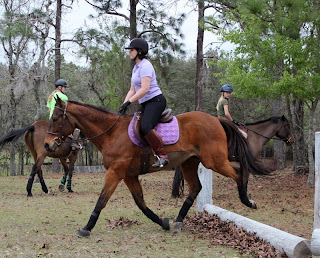 |
| Photo courtesy Martin Wessley |
So many times we’re tempted to procrastinate, to quit, or,
worse, not to try at all, because something we want to do is complicated or
doesn’t come easily. Just once, I’d like to try something new and find it
immediately easy, but this has not been my experience with even my favorite
activities: horseback riding, sketching, yoga, writing. These activities often
push me well outside my comfort zone, but they have given me hours of
happiness. I still don’t find them “easy,”—easier, yes, but not easy.
Maybe easy is not the point?
Worthwhile pursuits—the ones that give us lasting
happiness—often don’t come easy. We have to practice, to put in the time and
effort to improve, or else we’ll be frustrated. And how many times do we opt
for the easier choice: the TV program, the mindless internet surfing, and so
on? What other factors keep us safe in our comfort zones instead of pursuing
the very things we say we want to pursue? In my experience, there are three
things that contribute to the inertia keeping us from enjoying challenging and
happy-making pastimes: comparing ourselves to others; worrying about what
others think; and not stopping to appreciate how far we’ve come.
Comparing ourselves with others. When we see someone
perform effortlessly (or even just better than we do), we compare ourselves to
them. Problem is, we compare our “inside” to their “outside.” We don’t know
their lives and experience. We don’t know what’s going on in their heads and
hearts, how easy or hard things are for them, how long it has taken for them to
make it look effortless. It may feel just as hard to them as it does to us,
only we can’t see that. “Comparison is the thief of joy,” according to Theodore
Roosevelt. If we must compare, we should compare ourselves to ourselves. (See
below.)
Worrying about what others think. If we’ve been
comparing ourselves to others and feel we’re falling short, we probably also
feel others are looking down on us. If we are new to a pastime or putting our
work out there for everyone to see, it’s only natural that we feel worried
about others’ responses. The truth? Most people don’t care what we do, or what
we look like while doing it. They are too busy worrying about themselves. While they’re otherwise occupied, we can do what we want without fear of what others think.
Not appreciating how far we’ve come. The first time I
took a horseback riding lesson, I was scared. Thrilled, but scared. My school
horse was big and, to my mind, unpredictable. My body was confused about pretty
much everything it was expected to do. Now, many years later, I’ve learned a
great deal about horses and riding, and many of my actions on horseback are
automatic. But since I’m still learning new things, I do have times when I
perform awkwardly, or just plain badly. I could get frustrated by this, but
because of my past experiences, I know not to give up if my first attempts are
awkward or embarrassing. Compared with how I rode as beginner (sorry, Tank),
I’ve come a long way.
Most things, if we keep at them, will become easier. We
won’t always feel awkward and embarrassed, we won’t always have to think so
hard about every action. Even if we’re trying something for the first time and
we’re awful, by stepping outside our comfort zones, we’re miles ahead of all
the people who haven’t been brave enough to try in the first place.
What challenging pursuit would you like to begin? What’s holding you back?





.jpg)


